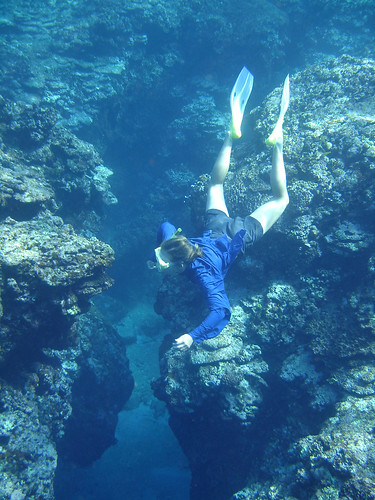snorkel
Eventually we meandered toward the outer edge of the reef, just exposed by the low tide. Seizing the opportunity, we pulled up the boats, donned snorkeling gear and dove in between the waves on the ocean side. The clarity of the sea was such as we had never seen before – rocks maybe 50 meters away were visible under water and diving felt like floating through air. A bewildering array of fish of all shapes, sizes, and colors were swimming about the bizarrely sculpted ramparts of the reef. Sea turtles cruised by nimbly, and large sea snakes wound about unhurriedly. Wanting to stay longer, we reluctantly returned to the boats as they were about to be set free by the rapidly rising tide.
Considering the jaw-dropping beauty of Yoron’s sea, it was a little surprising that we saw so few tourists here, at the height of Japan’s beach-going season. Later that evening, at a small noodle shop in downtown Chabana (Yoron’s main town, whose romantic-sounding name – Tea Flower – belies its utterly ordinary concrete-block demeanor) explained to us the reality of Japan’s tourist trade. Yoron had indeed been a popular destination years ago when all points south were still in the hands of the Americans and this had been Japan’s southernmost island…more than because of its natural beauty, the tourists flocked here due to this trivial fact. (Now, tiny Haderuma island about three degrees of latitude further south and west enjoys that privilege, and there is indeed a monument there in front of which visitors do line up for the obligatory photos.) Besides, now the American dollar is three times cheaper than it was then and everyone goes to Hawaii, where a similar beach is likely to be crowded by a thousand people. But the prestige of going overseas for the Japanese outweighs such trifling details. Thus the wandering gaijin in Japan may happen upon one gem of a place after another, hardly meeting anyone along the way. Planning our camping places before departure, we had thought it better to avoid any beaches specifically mentioned on the Internet, since such places here in Kyushu often prohibit camping or else charge exorbitantly for it. Although 215 other suitable beaches along our route were dutifully geo-coded from topographical maps (available freely online), this kind of thinking was turning out to be completely unwarranted. No one ever minded us camping anywhere: public beaches or the convenient flat concrete of the fishing harbors.



0 Comments:
Post a Comment
<< Home